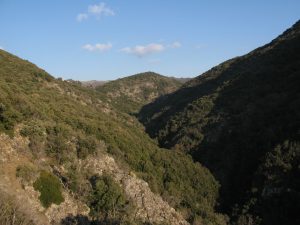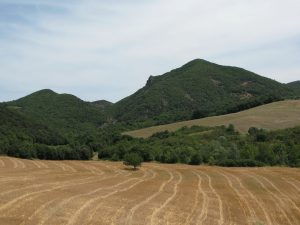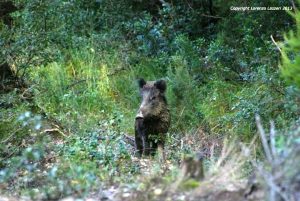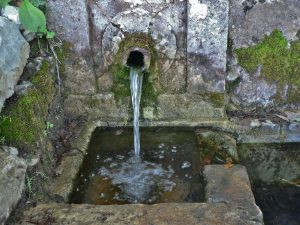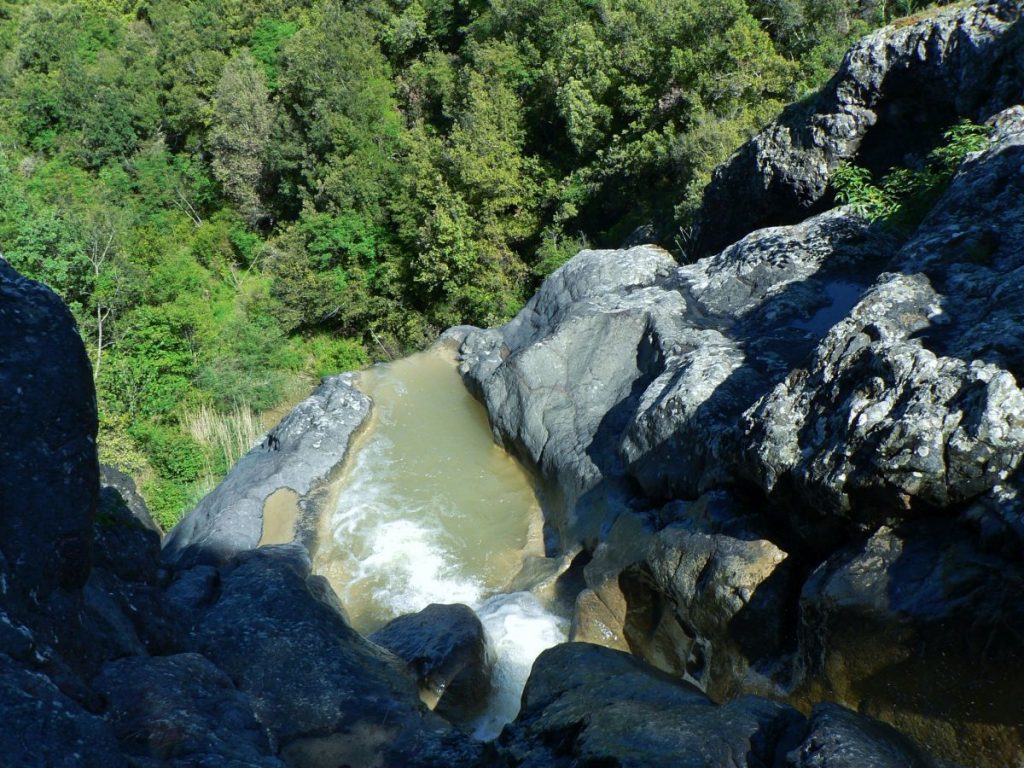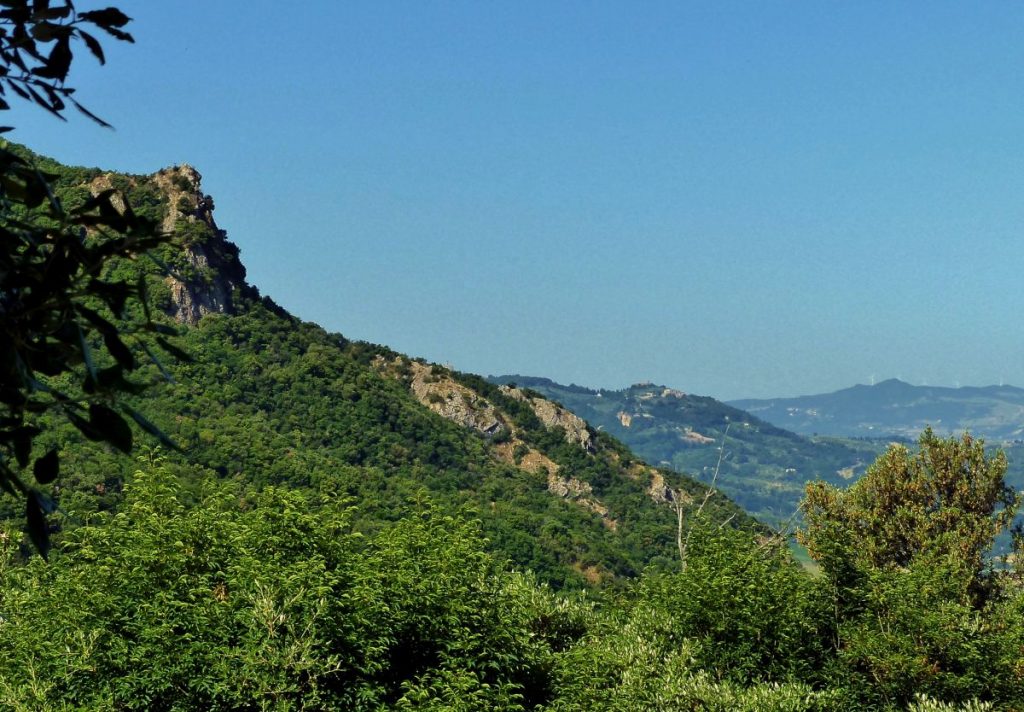
Montenero Nature Reserve
Located on the hills of Alta Valdera, between Volterra and San Gimignano, the Reserve extends over the northern slopes of Monte Nero (508 m), a modest but impassable hill behind the famous Villa di Ulignano. It opens up like a sudden wooded island with glimpses of rocky environments among the vast agricultural areas of the surrounding rolling hills, typical of the Tuscan landscape: the area is recognised by Europe as a Special Area of Conservation.
Despite its small size (about 69 hectares), a visit to the reserve allows you to observe some of the most characteristic environments of the landscape of the Nature Reserves in a short space of time.
From the evergreen woods – dominated by holm oaks – to the reforestation of conifers, from the peculiar environments characterized by the outcropping of basaltic lava rocks to the clear waters of the Strolla Torrent, which has deeply engraved the relief, drawing a suggestive and spectacular gorge with small waterfalls and pools, there is a succession of fascinating landscapes.
Ungulates and birds of prey live undisturbed, suddenly appearing in the sky or in the scrub. Unexpected and surprising, in the Strolla valley are the remains of an ancient parish church, known as the Pieve della Nera, dedicated to St. John the Baptist, located on a branch of the ancient road Via Salaiola that connects with the road Via Francigena; not far away, the remains of a medieval castle perched on a limestone plateau.
There are so many surprises in this remote corner of Tuscany, all to be discovered thanks to a ring-route crossing the entire Reserve, giving us a small mosaic of different environments to visit in every season of the year, enriched by important historical and architectural testimonies, a dip in nature and beauty just a stone’s throw from Volterra.
Located on the hills of Alta Valdera, between Volterra and San Gimignano, the Reserve extends over the northern slopes of Monte Nero (508 m), a modest but impassable hill behind the famous Villa di Ulignano. It opens up like a sudden wooded island with glimpses of rocky environments among the vast agricultural areas of the surrounding rolling hills, typical of the Tuscan landscape: the area is recognised by Europe as a Special Area of Conservation.
Despite its small size (about 69 hectares), a visit to the reserve allows you to observe some of the most characteristic environments of the landscape of the Nature Reserves in a short space of time.
From the evergreen woods – dominated by holm oaks – to the reforestation of conifers, from the peculiar environments characterized by the outcropping of basaltic lava rocks to the clear waters of the Strolla Torrent, which has deeply engraved the relief, drawing a suggestive and spectacular gorge with small waterfalls and pools, there is a succession of fascinating landscapes.
Ungulates and birds of prey live undisturbed, suddenly appearing in the sky or in the scrub. Unexpected and surprising, in the Strolla valley are the remains of an ancient parish church, known as the Pieve della Nera, dedicated to St. John the Baptist, located on a branch of the ancient road Via Salaiola that connects with the road Via Francigena; not far away, the remains of a medieval castle perched on a limestone plateau.
There are so many surprises in this remote corner of Tuscany, all to be discovered thanks to a ring-route crossing the entire Reserve, giving us a small mosaic of different environments to visit in every season of the year, enriched by important historical and architectural testimonies, a dip in nature and beauty just a stone’s throw from Volterra.
The tracks of Montenero Nature Reserve
1 - The Via del sale and the landscapes of the Alta Val d'Era
Forests and habitats characterized by rock outcrops are the two most typical aspects of the Reserve’s vegetation. The ophiolitic rocks (basalts) condition the ecology and the landscape of the area; these rocks give rise to poor soils, very hostile to plants, but with the presence of rare species that are exclusive to these soils (serpentinophytes), as well as of precious spring flowers. The meadows are also home to species of considerable interest, such as Etruscan saffron (Crocus etruscus), St. John’s lily (Lilium croceum), Tuscan bellflower (Campanula medium) and numerous orchids.
In spring, looking out from the extraordinary rocky spur, known as the “tooth of Montenero”, it is possible to observe the widespread flowering of laburnum, which dots the rocky woods overlooking the valley of the Strolla torrent with yellow.
The woods are made up of formations dominated by holm oaks, and secondarily by maples, manna ashes, rowan trees and wild ferns, which on the northern slopes become damp holm oaks mixed with hornbeams and a rich undergrowth of ferns. The warm areas with outcropping soil are home to patches dominated by the presence of Mediterranean plants such as phillyrea, lentisk, myrtle, strawberry tree, cistus and heather.
Forests and habitats characterized by rock outcrops are the two most typical aspects of the Reserve’s vegetation. The ophiolitic rocks (basalts) condition the ecology and the landscape of the area; these rocks give rise to poor soils, very hostile to plants, but with the presence of rare species that are exclusive to these soils (serpentinophytes), as well as of precious spring flowers. The meadows are also home to species of considerable interest, such as Etruscan saffron (Crocus etruscus), St. John’s lily (Lilium croceum), Tuscan bellflower (Campanula medium) and numerous orchids.
In spring, looking out from the extraordinary rocky spur, known as the “tooth of Montenero”, it is possible to observe the widespread flowering of laburnum, which dots the rocky woods overlooking the valley of the Strolla torrent with yellow.
The woods are made up of formations dominated by holm oaks, and secondarily by maples, manna ashes, rowan trees and wild ferns, which on the northern slopes become damp holm oaks mixed with hornbeams and a rich undergrowth of ferns. The warm areas with outcropping soil are home to patches dominated by the presence of Mediterranean plants such as phillyrea, lentisk, myrtle, strawberry tree, cistus and heather.
The tracks of Montenero Nature Reserve
1 - The Via del sale and the landscapes of the Alta Val d'Era
This small reserve on the border between the agricultural landscape of the valley Val d’Era and the vast forests of the Val di Cecina is a real jewel of plant and animal biodiversity that can be experienced by following a path that goes all around Montenero and explores its most hidden corners. With due respect for the peace and quiet of these places and habitats, it is possible to encounter both the fauna typical of the woodland environment and that more closely linked to the agricultural environment, mainly cultivated with cereals and olives. Among the mammals of the forest environment, in addition to the wild boar, there are porcupines, martens and squirrels; the roe deer, on the other hand, frequents more shrubby areas at the edge of the woods, while there are numerous species of birds, such as wood pigeons, chaffinches, greater spotted woodpeckers, creepers and firecrests, which find their ideal habitat in the woods.
On the other hand, at the borders of the reserve there are bird species of the so-called “cereal steppe”, i.e., of cereal fields, such as skylarks, crested larks, red-backed shrikes and woodchat shrikes.
There are many species that live for food in the border areas between the woods and the cultivated fields; here you are more likely to see most of the animals, including carnivores such as foxes, badgers, stone martens and skunks.
It is advisable to stop at the many viewpoints and cast your eyes upwards to watch the flight of birds of prey, especially diurnal ones such as the short-toed eagle, honey buzzard, kestrel and sometimes the peregrine; nocturnal birds of prey such as the tawny owl, scops owl and barn owl are also present. Unlike in large forests, in this small protected area fauna is relatively easy to observe due to its varied environmental mosaic and density of species. In addition to more conspicuous species such as mammals and birds, there are also numerous reptiles such as field and wall lizards, green lizards, vipers, green whip snakes and aesculapian snakes. These species are favoured by the presence of rocky environments with well-exposed rocks, where the reptiles, cold-blooded animals, can easily warm themselves.
The Strolla stream and the cool pools that run through the relief are the habitat for amphibians such as the Italian frog, the agile frog and the common toad. A bird that is not common in the area, the grey wagtail, nests in these environments. Its presence, usually associated with mountain areas, indicates the presence of a particularly cool and humid microclimate. In the pools of water dug out of the basalt it is possible to recognise some species of fish such as the small rovella with its typical reddish fins and the vairone.
Many of these animal species are now rare and endangered, so please do not disturb them and stay on the marked paths, limit noise to a minimum and keep your dogs on a leash, do not leave any kind of waste, including food waste, and take the utmost care, especially during the spring breeding season.
This small reserve on the border between the agricultural landscape of the valley Val d’Era and the vast forests of the Val di Cecina is a real jewel of plant and animal biodiversity that can be experienced by following a path that goes all around Montenero and explores its most hidden corners. With due respect for the peace and quiet of these places and habitats, it is possible to encounter both the fauna typical of the woodland environment and that more closely linked to the agricultural environment, mainly cultivated with cereals and olives. Among the mammals of the forest environment, in addition to the wild boar, there are porcupines, martens and squirrels; the roe deer, on the other hand, frequents more shrubby areas at the edge of the woods, while there are numerous species of birds, such as wood pigeons, chaffinches, greater spotted woodpeckers, creepers and firecrests, which find their ideal habitat in the woods.
On the other hand, at the borders of the reserve there are bird species of the so-called “cereal steppe”, i.e., of cereal fields, such as skylarks, crested larks, red-backed shrikes and woodchat shrikes.
There are many species that live for food in the border areas between the woods and the cultivated fields; here you are more likely to see most of the animals, including carnivores such as foxes, badgers, stone martens and skunks.
It is advisable to stop at the many viewpoints and cast your eyes upwards to watch the flight of birds of prey, especially diurnal ones such as the short-toed eagle, honey buzzard, kestrel and sometimes the peregrine; nocturnal birds of prey such as the tawny owl, scops owl and barn owl are also present. Unlike in large forests, in this small protected area fauna is relatively easy to observe due to its varied environmental mosaic and density of species. In addition to more conspicuous species such as mammals and birds, there are also numerous reptiles such as field and wall lizards, green lizards, vipers, green whip snakes and aesculapian snakes. These species are favoured by the presence of rocky environments with well-exposed rocks, where the reptiles, cold-blooded animals, can easily warm themselves.
The Strolla stream and the cool pools that run through the relief are the habitat for amphibians such as the Italian frog, the agile frog and the common toad. A bird that is not common in the area, the grey wagtail, nests in these environments. Its presence, usually associated with mountain areas, indicates the presence of a particularly cool and humid microclimate. In the pools of water dug out of the basalt it is possible to recognise some species of fish such as the small rovella with its typical reddish fins and the vairone.
Many of these animal species are now rare and endangered, so please do not disturb them and stay on the marked paths, limit noise to a minimum and keep your dogs on a leash, do not leave any kind of waste, including food waste, and take the utmost care, especially during the spring breeding season.
The tracks of Montenero Nature Reserve
1 - The Via del sale and the landscapes of the Alta Val d'Era
The “island” appearance of the reserve is even more evident as we discover, step by step, the geology and the very varied morphology of the area, with its continuous ups and downs.
At Monte Nero, at times it is like walking on the bottom of an ancient ocean formed by the eruptions of submarine volcanoes, where the lava cooled, giving rise to these dark rocks that we have under our feet.
The impervious Monte Nero relief, its northern slopes and most of the high basin of the Torrente Strolla are in fact composed of ophiolitic rocks. These are fragments of oceanic crust from the Jurassic period, about 180 million years ago, created following the transformation of deep rocks and the rising and cooling of magma along the fractures opened at the bottom of an ancient sea, as happens today along the mid-Atlantic ridge.
At Monte Nero, a particular type of ophiolite emerges, basalt, effusive rock of submarine volcanoes, dark in colour, ranging from red-brown to black, which contrasts well with the light colours of the surrounding limestone and clays and from which the place name Monte Nero originates.
This island of rock, surrounded by the more recent Pliocene sand-clay hills, underlines the close relationship between the nature of the terrain and the shapes of the reliefs, which are more rugged and emerging in the inner portion of the Reserve, and gentler in the surrounding areas. These characteristics are evident when walking along the path inside the Reserve, which goes around Monte Nero from the east and descends into the impervious valley of the Strolla stream, whose erosive action on the basaltic lava has created a precious natural environment.
The path that enters the gorge leads to a suggestive waterfall of about 30 m, known as the “Acqua cascata”. Isolated cliffs, eroding detrital slopes and vertical walls create the setting for some suggestive little waterfalls and for a peculiar gorge environment where numerous species of serpentine plants, i.e. plants that have adapted or evolved in these particular soil conditions, find their ideal habitat. On the hydrographic right of the Strolla stream, the relief of Poggio Casalone differs from the surrounding area due to its calcareous nature, forming a small plateau where the striking rocky outcrops represented an imposing natural defence for the medieval castle of the Nera.
Some reports by local historians and geographers of the 16th-17th centuries speak of past eras in which “it is common knowledge that gold was mined here”, but it is most likely Marcasite, an iron sulphide, or copper minerals with metallic colours similar to gold, certainly present in these rocks and unsuccessfully sought in the 19th century.
The black ophiolites of Monte Nero were then quarried and used in the past as a decorative building material for some of Volterra’s architectural works such as the Duomo, wrongly defined as black marble.
The “island” appearance of the reserve is even more evident as we discover, step by step, the geology and the very varied morphology of the area, with its continuous ups and downs.
At Monte Nero, at times it is like walking on the bottom of an ancient ocean formed by the eruptions of submarine volcanoes, where the lava cooled, giving rise to these dark rocks that we have under our feet.
The impervious Monte Nero relief, its northern slopes and most of the high basin of the Torrente Strolla are in fact composed of ophiolitic rocks. These are fragments of oceanic crust from the Jurassic period, about 180 million years ago, created following the transformation of deep rocks and the rising and cooling of magma along the fractures opened at the bottom of an ancient sea, as happens today along the mid-Atlantic ridge.
At Monte Nero, a particular type of ophiolite emerges, basalt, effusive rock of submarine volcanoes, dark in colour, ranging from red-brown to black, which contrasts well with the light colours of the surrounding limestone and clays and from which the place name Monte Nero originates.
This island of rock, surrounded by the more recent Pliocene sand-clay hills, underlines the close relationship between the nature of the terrain and the shapes of the reliefs, which are more rugged and emerging in the inner portion of the Reserve, and gentler in the surrounding areas. These characteristics are evident when walking along the path inside the Reserve, which goes around Monte Nero from the east and descends into the impervious valley of the Strolla stream, whose erosive action on the basaltic lava has created a precious natural environment.
The path that enters the gorge leads to a suggestive waterfall of about 30 m, known as the “Acqua cascata”. Isolated cliffs, eroding detrital slopes and vertical walls create the setting for some suggestive little waterfalls and for a peculiar gorge environment where numerous species of serpentine plants, i.e. plants that have adapted or evolved in these particular soil conditions, find their ideal habitat. On the hydrographic right of the Strolla stream, the relief of Poggio Casalone differs from the surrounding area due to its calcareous nature, forming a small plateau where the striking rocky outcrops represented an imposing natural defence for the medieval castle of the Nera.
Some reports by local historians and geographers of the 16th-17th centuries speak of past eras in which “it is common knowledge that gold was mined here”, but it is most likely Marcasite, an iron sulphide, or copper minerals with metallic colours similar to gold, certainly present in these rocks and unsuccessfully sought in the 19th century.
The black ophiolites of Monte Nero were then quarried and used in the past as a decorative building material for some of Volterra’s architectural works such as the Duomo, wrongly defined as black marble.
The tracks of Montenero Nature Reserve
1 - The Via del sale and the landscapes of the Alta Val d'Era
We are in the Alta Valdera in the catchment area of the Era river, a tributary of the Arno river. Over the millennia, the Strolla torrent has deeply furrowed these rugged reliefs of the Reserve in its upstream section. Erosion has laid bare the dark rocks of the basalts, whose lava nature is evident in the outcropping of rounded cushion-like rock masses.
The landscape of this narrow valley is picturesque and unexpected and appears to our eyes as a wild and inaccessible spectacular picture; the path running through the Reserve suddenly becomes “mountainous” and narrow and is dominated by steep and impervious slopes with picturesque waterfalls that follow one another in a highly natural environment.
The stream crosses large wooded areas further upstream, while here it flows embedded between steep cliffs dominated by a characteristic rocky spur known as the “tooth of Montenero”, so that its waters are clear and uncontaminated.
In these deep gorges, the presence of a cool and humid microclimate typical of more mountainous areas has favoured the presence of plant and animal species that are more demanding of such conditions.
Some of the bends in the stream are home to small nuclei of red and white willows, rushes and reeds, as well as specimens of water hemp and water mint, while the rocky walls are home to numerous species of ferns such as polypodies and Venus hair fern, whose delicate foliage, with its light green wedge-shaped leaves, deserves a reference to the crown of Venus, the goddess of beauty. Higher up, the warm rocky walls are home to numerous species of arid environments such as myrtle, broom, mastic, some succulent plants such as Sedum, aromatic species such as helichrysum and chamédrio and the beautiful flowers of the Tuscan campanula, as well as those of a small rock tree, the laburnum, which in May gives us flashes of yellow from its flowering clusters.
To fully enjoy the beauty of the watercourse environment, a visit in spring or early summer is recommended as there is still sufficient water; however, remember that this is also a particularly delicate period for the reproduction of birds and amphibians.
IMPORTANT: The watercourses can only be reached near the marked paths. For reasons of habitat conservation and safety, ascending all watercourses is prohibited. Ascents and guided excursions can be authorised by the Regional Office that manages the Reserves.
We are in the Alta Valdera in the catchment area of the Era river, a tributary of the Arno river. Over the millennia, the Strolla torrent has deeply furrowed these rugged reliefs of the Reserve in its upstream section. Erosion has laid bare the dark rocks of the basalts, whose lava nature is evident in the outcropping of rounded cushion-like rock masses.
The landscape of this narrow valley is picturesque and unexpected and appears to our eyes as a wild and inaccessible spectacular picture; the path running through the Reserve suddenly becomes “mountainous” and narrow and is dominated by steep and impervious slopes with picturesque waterfalls that follow one another in a highly natural environment.
The stream crosses large wooded areas further upstream, while here it flows embedded between steep cliffs dominated by a characteristic rocky spur known as the “tooth of Montenero”, so that its waters are clear and uncontaminated.
In these deep gorges, the presence of a cool and humid microclimate typical of more mountainous areas has favoured the presence of plant and animal species that are more demanding of such conditions.
Some of the bends in the stream are home to small nuclei of red and white willows, rushes and reeds, as well as specimens of water hemp and water mint, while the rocky walls are home to numerous species of ferns such as polypodies and Venus hair fern, whose delicate foliage, with its light green wedge-shaped leaves, deserves a reference to the crown of Venus, the goddess of beauty. Higher up, the warm rocky walls are home to numerous species of arid environments such as myrtle, broom, mastic, some succulent plants such as Sedum, aromatic species such as helichrysum and chamédrio and the beautiful flowers of the Tuscan campanula, as well as those of a small rock tree, the laburnum, which in May gives us flashes of yellow from its flowering clusters.
To fully enjoy the beauty of the watercourse environment, a visit in spring or early summer is recommended as there is still sufficient water; however, remember that this is also a particularly delicate period for the reproduction of birds and amphibians.
IMPORTANT: The watercourses can only be reached near the marked paths. For reasons of habitat conservation and safety, ascending all watercourses is prohibited. Ascents and guided excursions can be authorised by the Regional Office that manages the Reserves.
The tracks of Montenero Nature Reserve
1 - The Via del sale and the landscapes of the Alta Val d'Era
Walking along the main path of the Reserve, it is possible to cross a landscape rich in historical evidence, where the agricultural landscape, the ancient Etruscan roads, the farms, the remains of parish churches and castles form a whole with the natural and landscape resources. Situated at the top of the splendid valley of the Strolla torrent, just outside the perimeter of the Reserve, is the Pieve della Nera, a church built around the year 1000 and dedicated to St John the Baptist. The religious building, built with the typical green rocks, was a centre of great importance in the ancient and extensive diocese of Volterra. Just before the Pieve, along an important Etruscan and then medieval road, is the legendary Fonte del Latte (Milk Spring), whose water, according to popular tradition, had the property of guaranteeing milk to pregnant women who drank it. On the rocky peak of the nearby plateau Poggio Casalone, as if to dominate the territory of the Reserve, it is possible to reach the few still visible remains of the medieval castle of the Nera.
In the Middle Ages, the unpaved road overlooked by the parish church, the castle and the fountain was an important link between the northern (towards Florence) and southern (towards Siena) Via Volterrana (the road towards Volterra). From the 10th century, these important communication and trade arteries were important salt routes (such as the Salaiola) connecting the salt pans on the Cecina River with Volterra, the Elsa Valley and Florence. The nearby Oratory of Sant’Ottaviano, the first tomb of the hermit saint protector of Volterra, was of great importance in the Middle Ages because the Municipality of Volterra kept its salt deposits there.
To the south, past the parish church, an ancient track leads to the farmhouse Podere Cafaggiolo and, further south, to the Villa di Ulignano, built in the 17th century by Admiral Jacopo Inghirami on the ruins of an ancient castle, and the Villa di Scopicci, both dominated by the mass of the mount Monte Nero.
Walking along the main path of the Reserve, it is possible to cross a landscape rich in historical evidence, where the agricultural landscape, the ancient Etruscan roads, the farms, the remains of parish churches and castles form a whole with the natural and landscape resources. Situated at the top of the splendid valley of the Strolla torrent, just outside the perimeter of the Reserve, is the Pieve della Nera, a church built around the year 1000 and dedicated to St John the Baptist. The religious building, built with the typical green rocks, was a centre of great importance in the ancient and extensive diocese of Volterra. Just before the Pieve, along an important Etruscan and then medieval road, is the legendary Fonte del Latte (Milk Spring), whose water, according to popular tradition, had the property of guaranteeing milk to pregnant women who drank it. On the rocky peak of the nearby plateau Poggio Casalone, as if to dominate the territory of the Reserve, it is possible to reach the few still visible remains of the medieval castle of the Nera.
In the Middle Ages, the unpaved road overlooked by the parish church, the castle and the fountain was an important link between the northern (towards Florence) and southern (towards Siena) Via Volterrana (the road towards Volterra). From the 10th century, these important communication and trade arteries were important salt routes (such as the Salaiola) connecting the salt pans on the Cecina River with Volterra, the Elsa Valley and Florence. The nearby Oratory of Sant’Ottaviano, the first tomb of the hermit saint protector of Volterra, was of great importance in the Middle Ages because the Municipality of Volterra kept its salt deposits there.
To the south, past the parish church, an ancient track leads to the farmhouse Podere Cafaggiolo and, further south, to the Villa di Ulignano, built in the 17th century by Admiral Jacopo Inghirami on the ruins of an ancient castle, and the Villa di Scopicci, both dominated by the mass of the mount Monte Nero.
The tracks of Montenero Nature Reserve
1 - The Via del sale and the landscapes of the Alta Val d'Era





